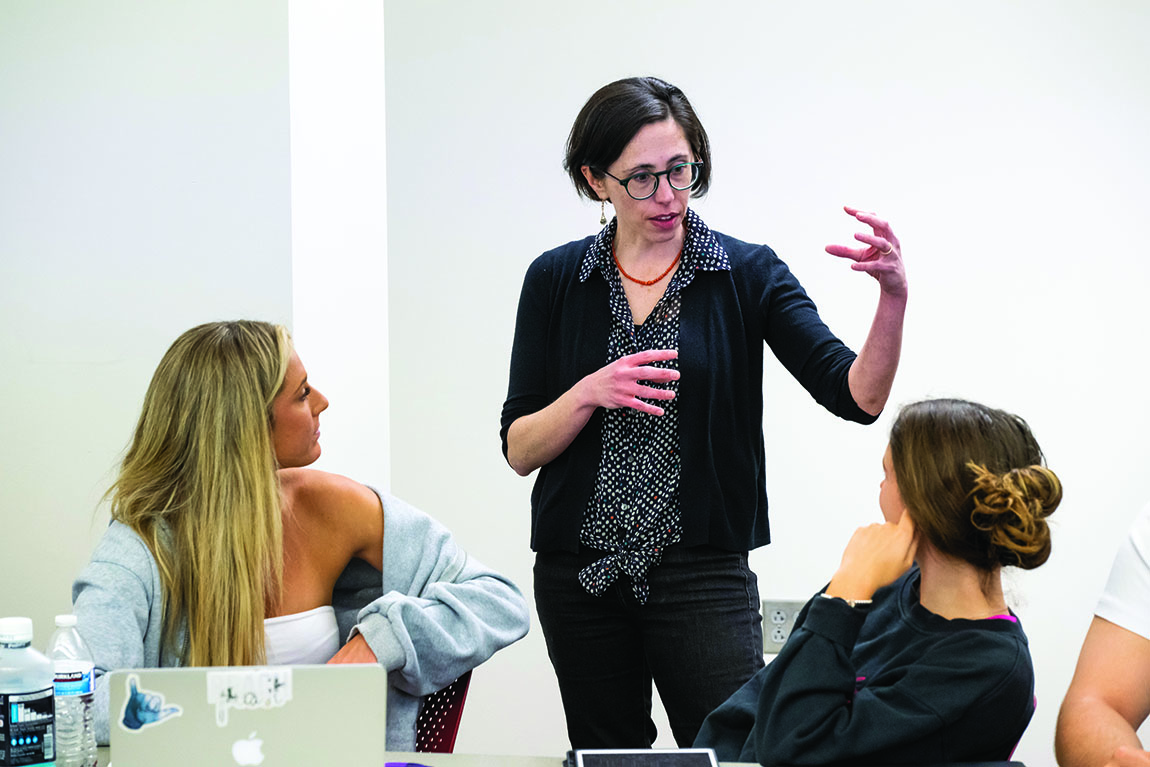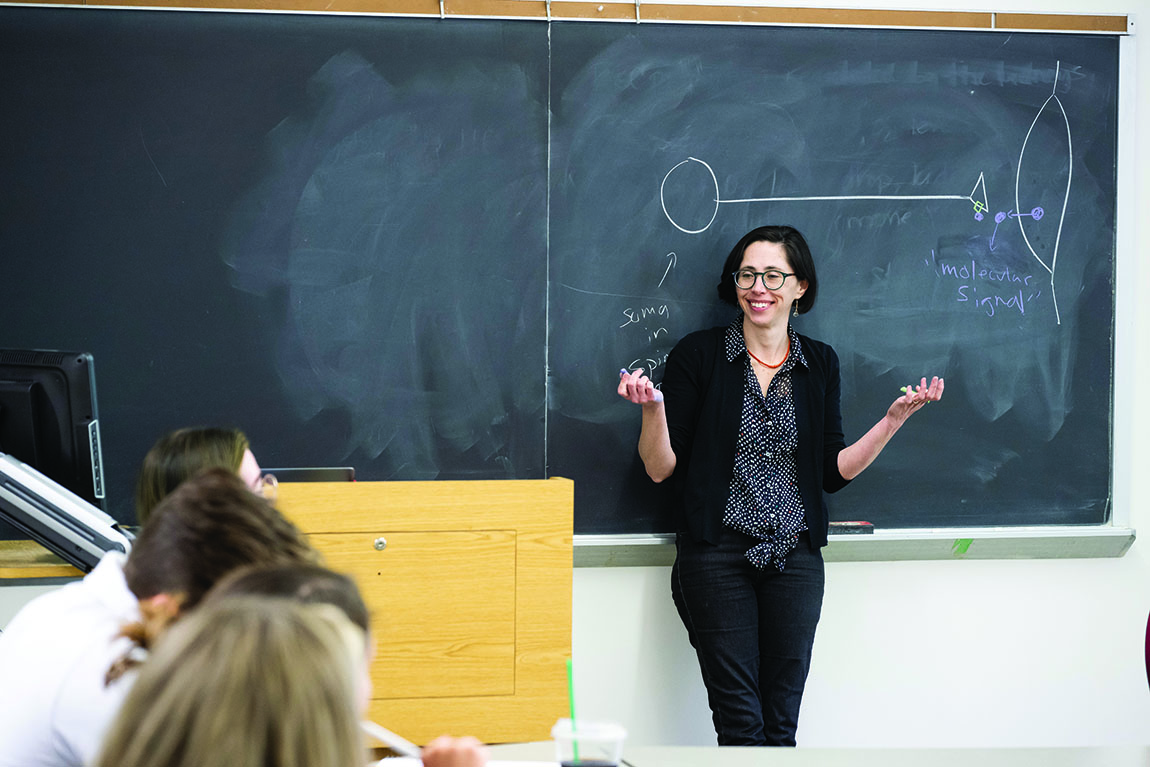Neural Connections
Assistant Professor of Neuroscience Leah Wilson strives to show students how what happens in the brain affects what happens in the body and how that is relevant across species, across academic disciplines and to just about every facet of students’ lives.By: Meghan Kita Monday, July 10, 2023 10:56 AM
 Assistant Professor of Neuroscience Leah Wilson teaching the course Neurons and Networks in Spring 2023. Photos by Lisa Helfert
Assistant Professor of Neuroscience Leah Wilson teaching the course Neurons and Networks in Spring 2023. Photos by Lisa HelfertAssistant Professor of Neuroscience Leah Wilson took one — and only one — neuroscience course as an undergrad: “I did not care for it very much,” she says.
At the time, she couldn’t see the connection to the fieldwork she knew she enjoyed. Wilson, a biology major at Oberlin College, conducted disease ecology research with a faculty member interested in the spread of West Nile virus. She spent her summers tracking birds and taking blood samples. She graduated and became a field assistant, the outdoor equivalent of a lab tech, working in Australia and New Hampshire.
“The projects were focused on [birds’] behavior, so there was a lot of behavioral observation, which is basically sitting quietly in the forest with a pair of binoculars,” she says. “We put plastic bands on their legs so that when you look at them from afar, you can tell the individual identity of a bird. This allows you to observe who’s hanging out with whom, who’s got a nest and the number of offspring, which opens the door to all sorts of questions about what determines reproductive success. It’s a huge concept in biology to think about what sorts of behaviors are adaptive and which are not adaptive.”

She went on to earn a master’s in behavioral ecology and a Ph.D. in evolution, ecology and behavior. In both programs, she studied birds, but as a doctoral student, she joined a lab focused on the brain. Her advisor, a neuroscientist, studied how birds’ neurochemical systems regulate whether they live in groups or not. Wilson’s dissertation explored whether those systems are seasonably variable: “Many birds flock in the winter but are territorial in the summer when they’re breeding,” she says. “That was my entry point into the chemical systems of the brain.” Her research found that these variations seem to revolve around how the animals respond to stressors: In the winter, when it’s cold and food is scarce, it may be adaptive to band together with other birds to stay warm and share the responsibility of finding food.
After completing her Ph.D., Wilson spent a few years as a visiting assistant professor at a college in Maine: “It’s there that I picked up some fish skills,” she says. A colleague had a research program centered around goldfish, and Wilson knew a fish-centric program would be more feasible than a bird-centric program at a small liberal arts school, which is where she hoped to land.
When Wilson joined Muhlenberg in 2019, she set up her lab to study the behavior of zebrafish, a social species whose neurochemical systems parallel those of other social animals, including humans. One line of questioning she and her students are investigating involves “social buffering,” or how much social experiences decrease the intensity of a stress response. The lab explores this by exposing fish to stressors when they’re alone in the tank and when they’re able to see other fish and recording how often they exhibit behaviors that correlate with high levels of stress hormones (freezing, going to the bottom of the tank, moving erratically). Students in Wilson’s lab are able to assist with ongoing projects like these or propose their own.
“We have weekly lab meetings. We talk about each other’s projects,” says Wilson. “In some ways this is my expectation, but it’s also a testament to the students who have ended up in my lab that everyone really wants to support everybody else … So much of what I enjoy about lab science is the lab culture and the chance to learn from other people’s projects.”
In the classroom, Wilson shares her specific realm of expertise through a pair of neuroscience electives: Hormones and Behavior, which explores the relationship between the brain and the body, and Sex, Gender and the Brain, which she describes as “one of my very favorite courses.”
“The conceit of the course is that neuroscience is often invoked in popular and scientific discourse as the ultimate authority on what sex is and what sexual categories are and where we draw the boundaries around them,” Wilson says. “Despite that, as a discipline, neuroscience has really ignored sex and gender at a very fundamental level. We don’t have a working definition of what sex is, how to define the sex of an individual animal. And at a larger level, we often exclude female animals from our experiments altogether … In this class, we start by unpacking how biology and neuroscience have come to think about sex and gender.”
One of the things Wilson enjoys about teaching this course is the diversity of the students who take it: scientists and nonscientists, first-year students and seniors, all bringing unique perspectives to an interdisciplinary conversation. And one of the things she enjoys about teaching at Muhlenberg in general is that it allows her to teach neuroscience in a way that might have resonated for her as an undergraduate.
“Teaching at a place like Muhlenberg affords the opportunity to always make explicit how the content of my course is connected to other things that students are experiencing in their lives and in their other courses,” Wilson says. “The liberal arts promise puts me in the mindset and has my students in the mindset of trying to see the connections between what they’re doing in my class and in other classes, and to me, that’s the most rewarding and engaging way to think about science.”
